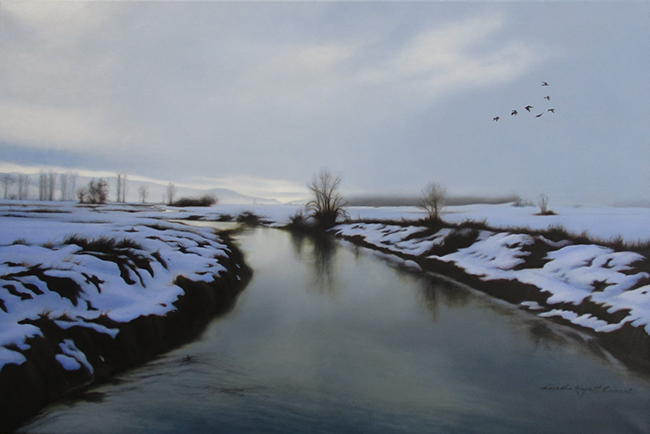Linda Cancel was born in 1959 in Moscow, Idaho, and from a young age, she has been deeply influenced by the landscapes and atmospheric beauty of the Pacific Northwest. Her earliest memory, watching fireworks above the Snake River at just fifteen months old, set the stage for a lifelong fascination with capturing the interplay of light, shadow, and form in her paintings.

In 1971, at the age of twelve, Linda began private oil painting lessons with the artist William F. Pogue. Under his mentorship, she fell in love with the process of painting, learning to create depth and dimension on canvas. Pogue’s admiration for the Golden Age of Illustration and the Wyeth family dynasty deeply resonated with Linda, further shaping her artistic vision.
Linda’s formal education at Spokane Falls Community College, where she majored in Visual Merchandising and Display Design, provided her with a solid foundation in color theory, design principles, and the impact of visual elements on an audience. This training has been instrumental in her ability to draw viewers into her work, creating an immediate and lasting impression.
For Linda, painting is more than just a visual endeavor; it’s an expression of her diverse interests in geology, history, and anthropology. Her works often evoke a sense of “spiritual geography” and “psychological archaeology,” blending elements of storytelling, cinema, and theater into a cohesive artistic performance. Each painting becomes a narrative, a moment captured in time that speaks to the viewer on multiple levels.
After spending twenty-five years on the East Coast, where she gained gallery representation, Linda returned to the West Coast in 2013. This move back to her roots was a full-circle journey, allowing her to reconnect with the landscapes that initially inspired her artistic path.
One of her notable works, “V is for Violet,” is a 24″x36″ oil on linen painting that perfectly encapsulates Linda’s ability to capture the essence of a place. The original photo reference was taken on a late January morning in the Colville River Valley in northeast Washington State. This painting reflects the peace and beauty of the region, a recurring theme in Linda’s dreams during her years on the east coast. The soft hues and gentle transitions of light in “V is for Violet” evoke a sense of poetic tonalism, transporting viewers to the tranquil landscapes that hold a special place in Linda’s heart.
Linda’s art is characterized by her use of atmosphere and light. She has an uncanny ability to convey the mood and essence of a landscape, making her viewers feel as if they are experiencing the scene firsthand. Her paintings often feature vast, open skies, rolling hills, and serene water bodies, all rendered with a keen eye for detail and a deep appreciation for the natural world.
The technical skill Linda developed under William F. Pogue’s guidance is evident in every brushstroke. Her work showcases a command of color and composition that draws the viewer’s eye and holds their attention. The influence of Pogue’s reverence for the Golden Age of Illustration is apparent in Linda’s approach to creating depth and dimension in her work.
Despite her technical prowess, Linda’s paintings are not just about technique. They are deeply personal and reflective of her own journey and experiences. Each piece tells a story, inviting viewers to explore not just the physical landscape but also the emotional and spiritual dimensions that Linda imbues in her work.
In her own words, Linda describes her painting process as an “expression of many interests,” blending her love for geology, history, anthropology, cinema, storytelling, and theater into a unique artistic vision. This multidisciplinary approach allows her to create works that are rich in meaning and resonance, each painting a performance that speaks to the viewer on multiple levels.
Linda Cancel’s art is a testament to her ability to capture the ephemeral beauty of the natural world and the complex interplay of light, atmosphere, and emotion. Her paintings invite viewers to step into her world, to experience the landscapes that have inspired her, and to find their own stories within the layers of color and form. As she continues to create and share her work, Linda remains dedicated to her never-ending quest to capture the effects of atmosphere on the landscape, a journey that began on the bluffs above the Snake River and continues to inspire her today.
4o

